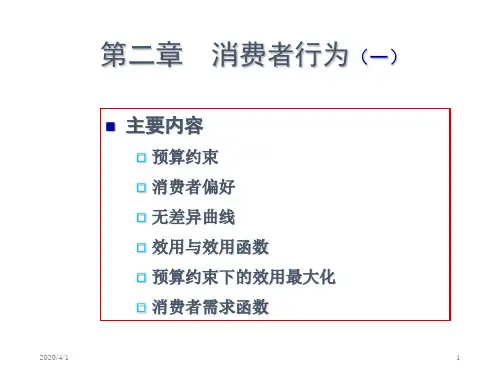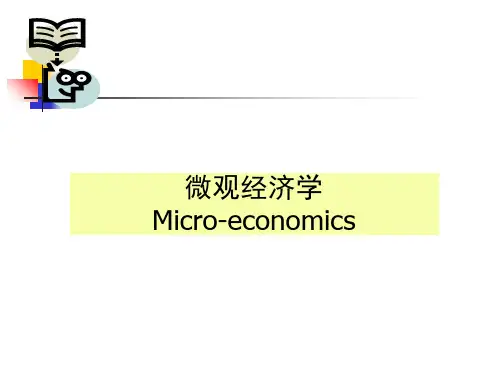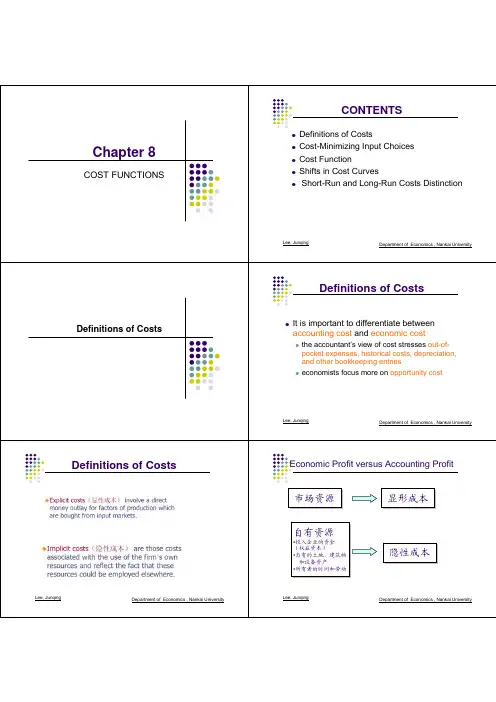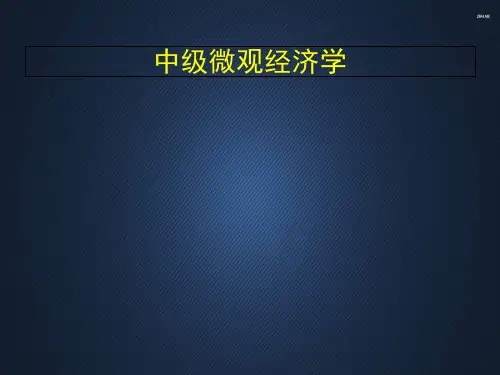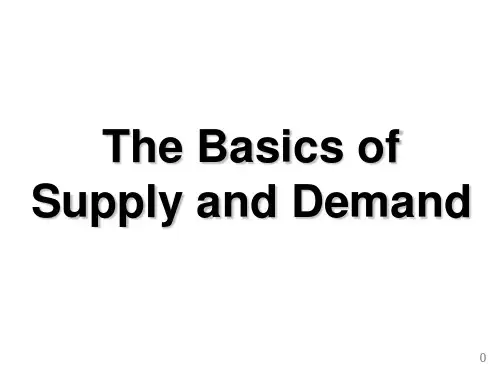- 1、下载文档前请自行甄别文档内容的完整性,平台不提供额外的编辑、内容补充、找答案等附加服务。
- 2、"仅部分预览"的文档,不可在线预览部分如存在完整性等问题,可反馈申请退款(可完整预览的文档不适用该条件!)。
- 3、如文档侵犯您的权益,请联系客服反馈,我们会尽快为您处理(人工客服工作时间:9:00-18:30)。
Utility Functions
A
utility function U(x) represents a preference relation f if and only if: ~ x’
x’ p x” x’ ~ x”
p
x”
U(x’) > U(x”)
U(x’) < U(x”) U(x’) = U(x”).
U MU i xi
Marginal Utilities
If
U(x1,x2) = x11/2 x22 then
U 1 1/ 2 2 MU1 x1 x2 x1 2 U 1/ 2 MU 2 2 x1 x2 x2
Marginal Utilities and Marginal Rates-of-Substitution
Some Other Utility Functions and Their Indifference Curves
Perfect
substitute – V(x1,x2) = x1 + x2. Perfect complement – W(x1,x2) = min{x1,x2} Quasi-linear – U(x1,x2) = f(x1) + x2 Cobb-Douglas Utility Function
8
min{x1,x2} = 8
min{x1,x2} = 5 min{x1,x2} = 3
5 3
3 5 8 x1 All are right-angled with vertices on a ray from the origin.
Quasi-Linear Utility Functions
A
utility function of the form
– U(x1,x2) = x1a x2b What do the indifference curves for these utility functions look like?
Perfect Substitution Indifference Curves
x2
13 9 5
x1 + x2 = 5
~
Goods, Bads and Neutrals
A
good is a commodity unit which increases utility (gives a more preferred bundle). A bad is a commodity unit which decreases utility (gives a less preferred bundle). A neutral is a commodity unit which does not change utility (gives an equally preferred bundle).
Equal
Utility Functions & Indiff. Curves
So
the bundles (4,1) and (2,2) are in the indiff. curve with utility level U But the bundle (2,3) is in the indiff. curve with utility level U 6. On an indifference curve diagram, this preference information looks as follows:
Chapter Four
Utility 效用
Structure
Utility
function (效用函数) – Definition – Monotonic transformation (单调转换) – Examples of utility functions and their indifference curves Marginal utility (边际效用) Marginal rate of substitution 边际替代率 – MRS after monotonic transformation
(2,3)
(4,1) ~ (2,2).
p
Utility Functions
= x1x2 (2,3) (4,1) ~ (2,2). Define V = U2. Then V(x1,x2) = x12x22 and V(2,3) = 36 > V(4,1) = V(2,2) = 16 so again (2,3) (4,1) ~ (2,2). V preserves the same order as U and so represents the same preferences.
Utility Functions & Indiff. Curves
(2,3)
p
x2
(2,2) ~ (4,1)
U6 U4
x1
Utility Functions & Indiff. Curves
Comparing
more bundles will create a larger collection of all indifference curves and a better description of the consumer’s preferences.
U(x1,x2)
p
p
Utility Functions
U(x1,x2)
= x1x2 (2,3) Define W = 2U + 10.
(4,1) ~ (2,2).
p
Utility Functions
= x1x2 (2,3) (4,1) ~ (2,2). Define W = 2U + 10. Then W(x1,x2) = 2x1x2+10 so W(2,3) = 22 > W(4,1) = W(2,2) = 18. Again, (2,3) (4,1) ~ (2,2). W preserves the same order as U and V and so represents the same preferences.
p
Utility Functions & Indiff. Curves
An
indifference curve contains equally preferred bundles.
preference same utility level. Therefore, all bundles in an indifference curve have the same utility level.
Utility Functions & Indiff. Curves
Consider
the bundles (4,1), (2,3) and
(2,2). Suppose (2,3) (4,1) ~ (2,2). Assign to these bundles any numbers that preserve the preference ordering; e.g. U(2,3) = 6 > U(4,1) = U(2,2) = 4. Call these numbers utility levels.
U(x1,x2)
p
p
Utility Functions: Monotonic Transformation
If
– U is a utility function that represents a preference relation f ~ and – f is a strictly increasing function, then V = f(U) is also a utility function representing f .
Utility Functions
Utility
is an ordinal (i.e. ordering) concept. [序数效用] E.g. if U(x) = 6 and U(y) = 2 then bundle x is strictly preferred to bundle y. But x is not preferred three times as much as is y.
Utility Functions & Indiff. Curves
x2
U6 U4 U2
x1
Utility Functions & Indiff. Curves
The
collection of all indifference curves for a given preference relation is an indifference map. An indifference map is equivalent to a utility function; each is the other.
x1
Cobb-Douglas Utility Function
Any
utility function of the form
U(x1,x2) = x1a x2b
with a > 0 and b > 0 is called a CobbDouglas utility function. E.g. U(x1,x2) = x11/2 x21/2 (a = b = 1/2) V(x1,x2) = x1 x23 (a = 1, b = 3)
Utility Functions
There
is no unique utility function representation of a preference relation. Suppose U(x1,x2) = x1x2 represents a preference relation. Again consider the bundles (4,1), (2,3) and (2,2).
